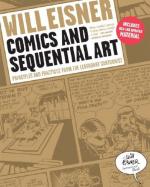
|
| Name: _________________________ | Period: ___________________ |
This test consists of 15 multiple choice questions and 5 short answer questions.
Multiple Choice Questions
1. The earliest use of balloons was in what type of art?
(a) Friezes.
(b) Dada.
(c) Scope.
(d) Impressionism.
2. What type of art does "Comics as a Form of Reading" describe?
(a) Phoenician watercolors.
(b) The modern form of sequential art.
(c) The ancient drawings at Lasceux.
(d) Linear art.
3. What two things limit the artist's choice of outline?
(a) The number of pens and pencils the artist owns.
(b) The scope and vision of the work.
(c) The sequential drive and linear focus of the page.
(d) The narrative requirement and constrictions on page dimensions.
4. Around when did daily comic strips first appear?
(a) 1934.
(b) 1943.
(c) 1756.
(d) 1956.
5. As artists tell stories to mass audiences, what do they use as means of arrangement?
(a) Triangles.
(b) Trapezoids.
(c) Bubbles.
(d) Boxes.
6. What specific content does Chapter 4 discuss?
(a) Broad ideas.
(b) Significant authors.
(c) Didactic dictation.
(d) Technical specifics.
7. What is the title of Chapter 4?
(a) Framing.
(b) Elements.
(c) Narrative.
(d) Sequence.
8. What characteristic of comics examines how the sequential artist works with space and time?
(a) Style.
(b) Illusion.
(c) Timing.
(d) Paneling.
9. What element of weather messes with the typeface in Eisner's second example?
(a) Snow.
(b) Lightning.
(c) Wind.
(d) Rain.
10. When does a pause inevitably occur while reading?
(a) While the reader/viewer moves from panel to panel.
(b) When the reader/viewer reads the second to last panel.
(c) When the reader/viewer turns the page.
(d) When the reader/viewer sees the first panel.
11. Stories can be told through what alone?
(a) Spirit.
(b) Signatures.
(c) Imagery.
(d) Focal points.
12. What does the storyteller want to cause the reader to do?
(a) To become extremist.
(b) To become isolated.
(c) To become involved.
(d) To become self-aware.
13. After which century, did artists start to depend on expressions, postures, and backdrops?
(a) 10th.
(b) 17th.
(c) 15th.
(d) 16th.
14. In "Contract with God" by Eisner, what does the stone tablet suggest?
(a) The One Principle.
(b) The Five Ideals.
(c) The Unity of the Mind.
(d) The Ten Commandments.
15. What Spirit story written in 1947 mentions Yogi?
(a) George and the Yogi.
(b) Hoagy the Yogi, Part 2.
(c) Junior Yogi, Part 2.
(d) Hoagy the Yogi, Part 1.
Short Answer Questions
1. Where does Eisner's second example in "Contract with God" take place?
2. As a language, what do comics need to utilize?
3. What can happen after letters in comics are devised from familiar objects?
4. What must a reader possess in order to read comic books?
5. In a story by Eisner how does he make the text express the sentiment of a scene?
|
This section contains 449 words (approx. 2 pages at 300 words per page) |

|




